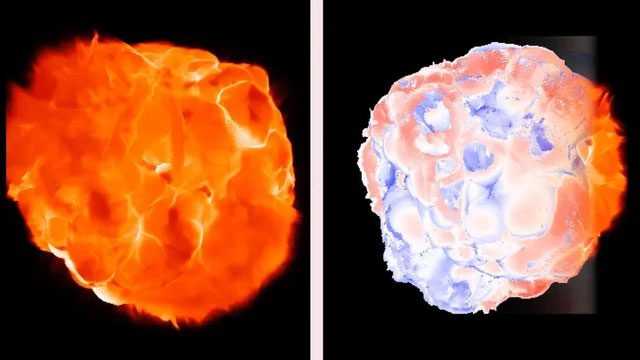Not only is it colossal, radiant, eerie, and always on the verge of exploding, the “monster” Betelgeuse may also create illusions for the eyes of Earthlings.
Recent observations of Betelgeuse – the giant red star located in the constellation Orion – indicate that it is spinning at an absurdly fast rate. However, a new study from the Max Planck Institute for Astrophysics (MPA, Germany) suggests that we might be witnessing an optical illusion.
The surface of this celestial object, which has intrigued astronomers for over 2,000 years, may be bubbling, as new analyses indicate.

Betelgeuse might be bubbling and distorted in its final stages of life – (Photo: MPA).
According to Live Science, simulations from various images of Betelgeuse reveal signs of convective processes dominating its surface. Therefore, its surface might resemble boiling water.
At a distance of approximately 500-600 light-years, this bubbling creates an illusion that leads astronomers to mistakenly believe it is rotating absurdly fast compared to what such large objects can actually do.
Astronomers have yet to fully explain the cause of this surface bubbling, but it could be one of the signs of its impending demise.
With a diameter exceeding 1 billion kilometers, Betelgeuse is more than 1,000 times larger than our Sun and is one of the largest known stars.
It also draws attention due to its frequent dimming and brightening in the sky. Moreover, observations from ancient times to the present indicate that this monster has changed colors.
According to records from the ancient Chinese scholar Sima Qian, around 2,100 years ago, Shen Shu Si – the ancient Chinese name for Betelgeuse – was described as bright yellow, not red like the other famous star Antares in the Scorpius constellation.
One hundred years later, the Roman scholar Hyginus described Betelgeuse as having a yellow-orange color similar to Saturn.
By the 16th century, Danish astronomer Tycho Brahe noted that Betelgeuse had become redder than Antares. Today, it is classified as a red supergiant.
This color change indicates that Betelgeuse is nearing the end of its life as a “red giant,” a state that stars reach as they exhaust their energy.
Betelgeuse could explode at any moment, emitting enough light to brighten the night sky of Earth before collapsing into a smaller object, potentially a neutron star, as it is a massive star.
Betelgeuse has often startled astronomers by suddenly dimming, leading people to believe it is about to explode. However, it still exists, glowing red. The dimming could merely be an illusion caused by an object or dust clouds expelled by the star itself.
With the bubbling illusion from its surface, Betelgeuse promises to continue fascinating and perplexing astronomers for the foreseeable future.


















































